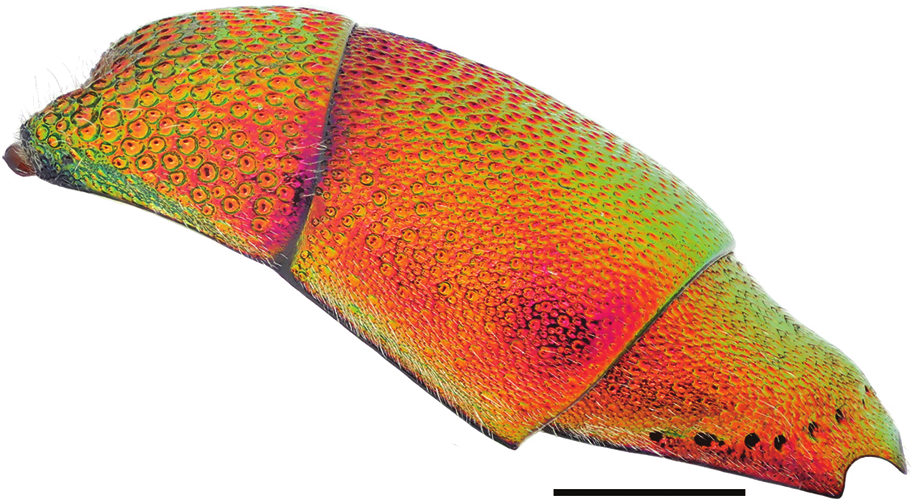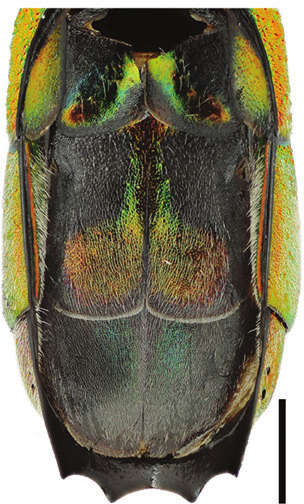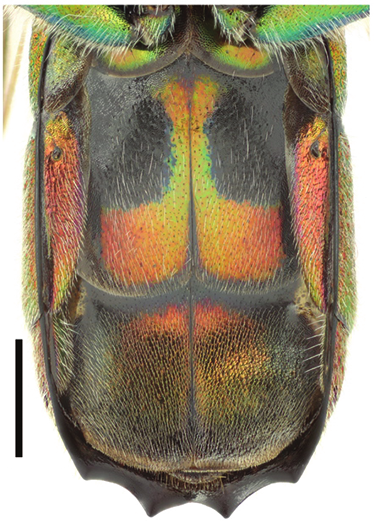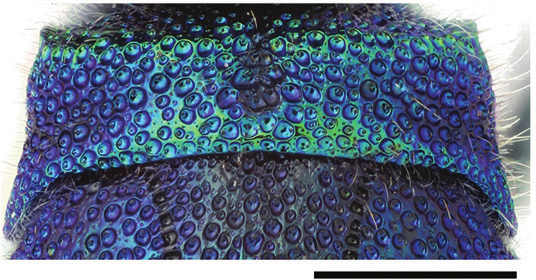Chrysis subcoriacea
A relatively rare species found in warm forest margins with large amounts of dead wood. The host is probably Ancistrocerus trifasciatus. The females are usually easy to distinguish from closely related species by the laterally coriaceous and dull T2 and T3 .
- Innhold
- Diagnosis
- Distribution
- Biology
Diagnosis
Figure 87
T3, dorsal view: C. subcoriacea ♂. Scale 1 mm.
Figure 109
Metasoma, lateral view: C. subcoriacea ♀. Scale 1 mm.
Figure 117
Metasoma, ventral view: C. subcoriacea ♀. Scale 1 mm.
Figure 129
Metasoma, ventral view: C. subcoriacea ♂. Scale 1 mm.
Figure 146
Head, lateral view: C. subcoriacea ♂. Scale 1 mm.
Figure 160
Pronotum, dorsal view: C. subcoriacea ♂. Scale 1 mm.
Figure 174
Antenna (arrow indicating F1 or F1 and F2): C. subcoriacea ♂. Scale 1 mm.
Length 9–13 mm.
Females are usually easy to recognise by the laterally coriaceous and dull T2 and T3 (Fig. 109). Males, however, are often confused with C. impressa and C. longula. Compared to C. impressa, the sternites are usually brighter red and the black spots of S2 larger (Fig. 129), the mandible thicker (Fig. 146) and the transition of the lateral margin of T3 into the lateral apical teeth is straighter (not concave) (Fig. 87). Compared to C. longula (Fig. 161), the middle part of the pronotum is not as sharply darker than the margins (Fig. 160), the lateral margins of T3 are straighter, the punctation of T2 is usually finer anteriorly, and the central interval of the apical teeth is more angled (Fig. 87). In both sexes, the head and mesosoma are dorsally dark blue or nearly black with light blue or greenish reflections mainly on the pronotum. The tergites and sternites are red. The body is elongate and often rather large.
Distribution
Denmark, Estonia, Finland, Latvia, Norway, Sweden. Relatively rare.
Trans-Palearctic: from Europe to central Asia and Japan (Linsenmaier 1997).
Be aware that the records present in the GBIF map may be misleading for some countries due to unrevised data sets or missing information.
GBIF Taxon: Chrysis subcoriacea Linsenmeier, 1959Biology
Habitat: forest margins, clearings and gardens with sun-exposed dead wood. Adults often fly near dead tree trunks (Betula, Populus, Salix) and close to walls of wooden buildings (log barns, sheds etc.), and they are also attracted to honeydew of aphids.
Flight period: late May to late August.
Host: possibly Ancistrocerus trifasciatus (Müller) (Vespidae) (our own obs.).







